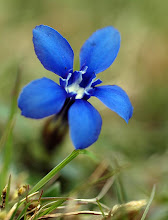When aphids infest plants they tend to find a good spot to feed and then stay in one place, where they'll insert their stylets into the plant's phloem, tap its sugary sap and then settle down to reproduce.
When you take a close look at plant surfaces you can sometimes see why these pests are more or less sedentary. Many plants, like this goosegrass Galium aparine, are covered with epidermal hairs (trichomes) that make it difficult to tiny aphids to move around.
In the case of goosegrass the hooked hairs are primarily for attaching their weak stems to supports as they grow, but those curved spines are also awkward obstacles for minute aphids to negotiate.


















I found your blog via this month's berry-go-round. After a bit of browsing through your plant posts, I was thoroughly enjoying myself ... a good discovery!
ReplyDeleteHi Hollis, Thanks for your kind comment and for visiting.
ReplyDeleteFound an aphid just like this, tho less green, on a grass I was trying to ID today. This blog post very useful.
ReplyDeleteReally tricky to identify, aren't they?!
Delete